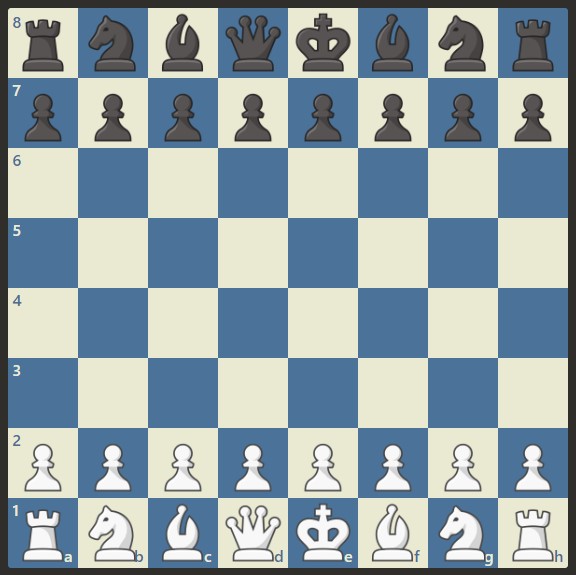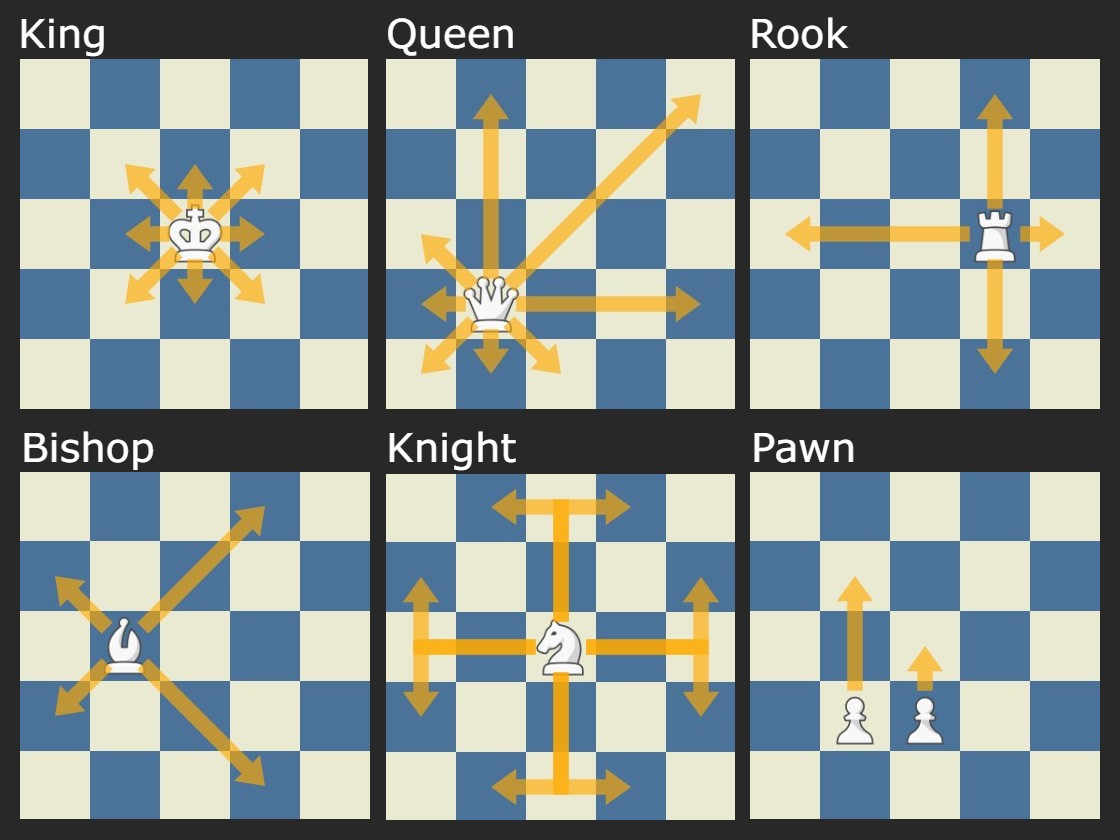Chess Basics: Learn How to Play Chess
Chessboard and Setup
Chessboard: Chess is played on a square board with 64 squares arranged in an 8x8 grid. The board should be placed so that each player has a white square on their right-hand side.
Chess Pieces: There are 32 pieces in chess, divided equally between two players. Each player has:
- 1 King
- 1 Queen
- 2 Rooks
- 2 Knights
- 2 Bishops
- 8 Pawns
Setup: Place the pieces on the board as shown below. The back rank should have Rooks in the corners, Knights next to them, followed by Bishops, with the Queen in the remaining square of her color. The King goes next to the Queen.

How the Pieces Move
Each chess piece moves differently:
King: The King moves one square in any direction (horizontally, vertically, or diagonally).
Queen: The Queen is the most versatile piece, moving horizontally, vertically, or diagonally any number of squares.
Rook: Rooks move in straight lines either horizontally or vertically, covering as many squares as available.
Bishop: Bishops move diagonally any number of squares.
Knight: Knights move in an L-shape: two squares in one direction and one square perpendicular to that. Knights are the only pieces that can “jump” over other pieces.
Pawn: Pawns move forward one square but capture diagonally. On their first move, pawns have the option to move forward two squares.

Objective of the Game
The ultimate goal in chess is to checkmate your opponent’s King. “Checkmate” occurs when the opponent’s King is under attack (in check) and cannot make any legal move to escape the threat. However, a game can also end in a draw or stalemate if specific conditions are met.
Special Rules
Castling: Castling is a special move that involves the King and one of the Rooks. It is the only move in chess where two pieces move simultaneously. The King moves two squares toward one of the Rooks, and that Rook then moves to the square the King crossed. Castling is a way to improve the safety of the King by moving it to a more secure position behind a wall of pawns.
En Passant: “En passant” is a unique pawn capture rule. If an opponent’s pawn moves two squares forward from its starting position, and it lands next to your pawn, you have the option to capture it as if it had moved only one square forward. This rule prevents pawns from bypassing your capture range.
Pawn Promotion: When a pawn reaches the opponent’s back rank (the eighth rank for White or the first rank for Black), it can be promoted to any other piece, usually a Queen. This rule allows pawns to transform into more powerful pieces when they reach the opponent’s territory.
Piece Values and Their Role in Exchanges
Understanding the value of each chess piece is fundamental to making informed decisions during a game. Piece values provide a guideline for assessing the relative strength of your pieces and your opponent’s, which, in turn, influences your choice of moves and piece exchanges.
- Pawn (1 Point)
- Knight (3 Points)
- Bishop (3 Points)
- Rook (5 Points)
- Queen (9 Points)
- King (Priceless)
Here’s a deeper look at how piece values factor into exchanges:
Assessing Imbalances: As you evaluate a position, you’ll notice imbalances in piece placement and activity. For example, if your opponent has a well-placed Knight and you have a less active Bishop, you might consider exchanging the Bishop for the Knight. Understanding piece values helps you gauge whether the exchange is favorable or not.
Creating Material Advantage: Chess is often a battle for material advantage. If you can capture higher-valued pieces while losing lower-valued ones in an exchange, you gain a material advantage. For example, trading your Knight (3 points) for your opponent’s Rook (5 points) results in a net gain of two points.
Endgame Considerations: In the endgame, the value of pawns can increase as they advance and threaten promotion to more powerful pieces. Understanding piece values helps you make decisions regarding pawn promotions and King activity.
Evaluating Sacrifices: Sometimes, sacrificing a higher-valued piece can lead to a strong attack or a winning endgame. Knowing the value of your pieces allows you to assess the potential gains and risks associated with sacrifices.
Keep in mind that while piece values provide a general guideline, the evaluation of positions can be complex, and other factors such as pawn structure, piece activity, and the overall position should also be considered. Additionally, piece values can change as the game progresses and the position evolves.
Mastery of piece values and their role in exchanges is a valuable skill in chess. It allows you to make strategic decisions that can lead to a stronger position and ultimately improve your chances of victory.
The Three Phases of a Chess Game
Opening Phase - Building Your Foundation: The opening phase is like laying the foundation of a house. In your chess journey, it’s the crucial first step. It covers the initial 10-15 moves where you establish control of the center, develop your pieces (knights, bishops, etc.), and secure your King’s safety through castling. The opening sets the stage for your entire game and is where you’ll choose from a variety of strategies and tactics.
Middlegame Phase - The Heart of Chess: Think of the middlegame as the heart of your chess adventure. This phase begins after the opening and is where the real action happens. Here, you get creative, look for tactical opportunities (like tricky moves and surprising attacks), and craft strategies to outmaneuver your opponent. It’s all about making the right moves to gain advantages and control the board.
Endgame Phase - Bringing It Home: As you advance in your chess skills, you’ll find yourself in the endgame, which is like the final stretch of a race. In this phase, the board is less cluttered, and you have fewer pieces to work with. It’s all about converting your advantages from the middlegame into a winning position. Endgame techniques involve precise moves to promote pawns, activate your King, and outmaneuver your opponent’s King. Mastering the endgame is often the key to winning more games.
Understanding these three phases will help you navigate your chess games more effectively and enjoy the journey from the opening moves to the final checkmate!